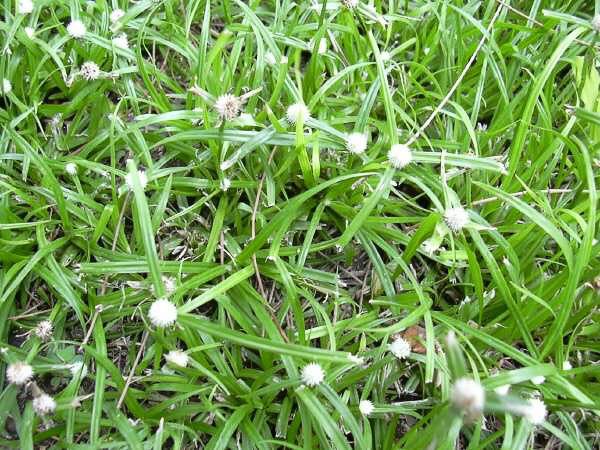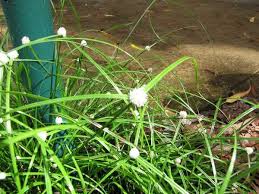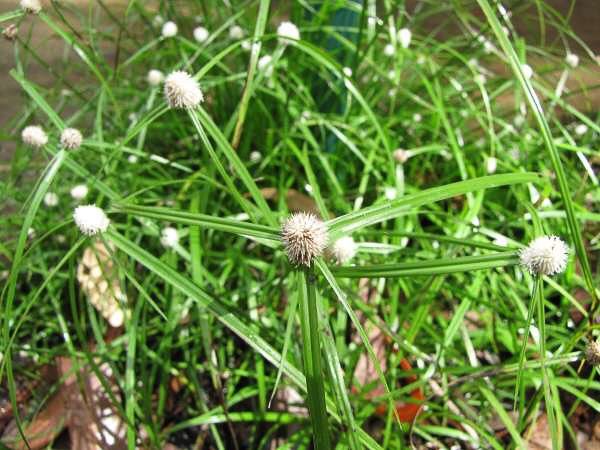White kyllinga (Kyllinga nemoralis) is a type of grass that grows in many places. People might not notice it much, but it’s there, quietly making its presence known. This grass is different from others, and we can learn interesting things about it.
In parks and lawns, White kyllinga can be found, often mixed in with other grasses. It has thin, light-green leaves that form a low carpet on the ground. Despite its unassuming appearance, it plays a role in the ecosystem.
This grass is a survivor, adapting to various conditions. It grows in both sunny and shady spots, making it a versatile plant. Its ability to thrive in different environments shows nature’s incredible diversity.
White kyllinga may seem ordinary, but it serves a purpose. It helps prevent soil erosion by covering the ground with its dense growth. This is vital for maintaining the health of the soil and supporting other plants.
While some might see it as a weed, White kyllinga has its charm. Its small, delicate flowers add a touch of beauty to the landscape. Even in simplicity, there is a unique elegance to this grass.
Understanding the life cycle of White kyllinga is fascinating. It spreads through seeds and rhizomes, creating a network beneath the surface. This allows it to persist and spread, adapting to changing conditions.
Gardening enthusiasts might have mixed feelings about White kyllinga. Some see it as a challenge to control, while others appreciate its ability to fill in bare areas. Finding a balance between maintaining a well-kept garden and allowing nature to take its course can be a delicate task.
In addition, White kyllinga, with its unpretentious demeanor, is an integral part of many landscapes. Its adaptability, contribution to soil health, and subtle beauty make it a noteworthy component of the natural world. Appreciating the simplicity and resilience of White kyllinga invites us to recognize the intricate tapestry of life that surrounds us.
Read Also: The Importance and Uses of Farm Credit
How To Grow White Kyllinga (Kyllinga nemoralis)

Growing White kyllinga (Kyllinga nemoralis) can be a straightforward process. Here’s a simple guide to help you cultivate this grass in your garden or lawn.
1. Soil Preparation: White kyllinga is adaptable, but it prefers well-draining soil. Ensure the soil is loose and not compacted. You can amend the soil with organic matter like compost to improve its texture.
2. Sunlight: White kyllinga can tolerate both sun and shade, but it generally thrives in areas with partial to full sunlight. Choose a location in your garden that receives an adequate amount of sunlight throughout the day.
3. Planting Seeds: If you’re starting from seeds, scatter them evenly over the prepared soil. Gently press them into the soil, but avoid burying them too deeply. Water the area regularly to keep the soil consistently moist until the seeds germinate.
4. Rhizome Planting: Alternatively, you can plant White kyllinga using rhizomes. These are underground stems that can be planted horizontally. Bury the rhizomes just beneath the soil surface, ensuring good soil contact.
5. Watering: White kyllinga prefers consistently moist soil. Water regularly, especially during dry periods. Avoid overwatering, as excessive moisture can lead to other issues.
6. Maintenance: Once White kyllinga is established, it requires minimal maintenance. Regular mowing at a higher setting can help control its height and encourage a dense growth. However, be mindful not to cut too short, as this may stress the grass.
7. Weed Control: Keep an eye on weeds that might compete with White kyllinga. Regular weeding will help maintain the grass’s dominance and prevent unwanted plants from taking over.
8. Fertilizing: White kyllinga is not overly demanding when it comes to fertilization. However, a balanced, general-purpose fertilizer applied in spring can promote healthy growth.
9. Enjoy the Benefits: As White kyllinga establishes itself, it contributes to the overall health of your garden. Its low, carpet-like growth can help prevent soil erosion and add a touch of greenery to your landscape.
By following these simple steps, you can successfully grow White kyllinga and appreciate its unique qualities in your outdoor space.
How To Care For White Kyllinga (Kyllinga nemoralis)
Caring for White kyllinga (Kyllinga nemoralis) involves some basic steps to ensure its well-being in your garden or lawn. Here’s a simple guide on how to care for this grass:
1. Watering: White kyllinga prefers consistently moist soil. Water the area regularly, especially during dry periods. However, avoid overwatering, as this can lead to issues like root rot. Aim for a balance to keep the soil consistently damp but not waterlogged.
2. Sunlight: While White kyllinga can tolerate various light conditions, it generally thrives in areas with partial to full sunlight. Ensure that the grass receives an adequate amount of sunlight for healthy growth.
3. Mowing: Regular mowing helps control the height of White kyllinga and encourages a dense growth. Set your mower to a higher setting to avoid cutting the grass too short, as this may stress it. Mow when the grass reaches a height that looks appropriate for your landscape.
4. Weed Control: Keep an eye on weeds that might compete with White kyllinga. Regular weeding helps maintain the grass’s dominance and prevents unwanted plants from taking over. Be cautious with herbicides, as they may affect White kyllinga along with other plants.
5. Fertilizing: White kyllinga is not highly demanding in terms of fertilization. However, applying a balanced, general-purpose fertilizer in spring can promote healthy growth. Follow the recommended dosage on the fertilizer packaging.
6. Soil Maintenance: Ensure that the soil remains well-draining. If the soil becomes compacted over time, consider aerating it to improve its structure. Adding organic matter like compost can also enhance the soil’s fertility.
7. Pest Management: White kyllinga is generally resistant to many pests. However, occasional inspection for pests like insects or diseases is advisable. If an issue arises, use appropriate measures like insecticidal soap or other targeted treatments.
8. Appreciate Its Natural Beauty: White kyllinga has its own charm, contributing to the aesthetics of your landscape. Take a moment to appreciate its subtle beauty and the unique role it plays in maintaining a healthy ecosystem.
By following these care tips, you can foster a thriving environment for White kyllinga. Remember that each garden or lawn is unique, so adjusting care practices based on your specific conditions will contribute to the success of this adaptable grass.
Read Also: The Benefits of Hydroponic Farming
The Uses of White Kyllinga (Kyllinga nemoralis)

White kyllinga (Kyllinga nemoralis) may be considered by some as a common grass, but it has several notable uses and contributions. Here are some of the key uses of White kyllinga:
1. Soil Erosion Prevention: White kyllinga forms a dense carpet on the ground, helping to prevent soil erosion. Its intricate root system stabilizes the soil, making it a valuable component for maintaining the integrity of landscapes.
2. Ground Cover: Due to its low, spreading growth habit, White kyllinga serves as an effective ground cover. It can fill in bare areas, providing green coverage and adding a touch of nature to lawns, gardens, and other open spaces.
3. Adaptability: White kyllinga is adaptable to different environmental conditions. It can thrive in both sunny and shady areas, showcasing its versatility. This adaptability makes it a resilient plant in various landscapes.
4. Eco-Friendly Landscaping: As a low-maintenance grass, White kyllinga contributes to eco-friendly landscaping practices. Its ability to grow without requiring excessive inputs makes it a sustainable choice for those looking to create environmentally conscious outdoor spaces.
5. Wildlife Habitat: The grass provides a habitat for small insects and other wildlife. The dense growth of White kyllinga can offer shelter and a foraging ground for beneficial insects, contributing to the overall biodiversity of the ecosystem.
6. Aesthetic Appeal: While subtle, White kyllinga adds a touch of greenery to lawns and gardens. Its delicate flowers and low-profile appearance contribute to the overall aesthetic appeal of outdoor spaces.
7. Soil Health Improvement: White kyllinga’s growth and decay contribute organic matter to the soil, enhancing its structure and fertility. This can have positive effects on the health of the soil and support the growth of other plants.
8. Adaptable Lawn Component: For those who appreciate a more natural and varied lawn, White kyllinga can be integrated into the landscape. Its adaptability makes it a candidate for lawns that experience varying light conditions throughout the day.
While White kyllinga may not be a showy or high-profile plant, its various uses and contributions make it a valuable part of many ecosystems. Whether it’s preventing soil erosion, serving as ground cover, or contributing to overall soil health, this grass plays a role in creating balanced and resilient outdoor environments.
Frequently Asked Questions (FAQs)
Q: What is White kyllinga (Kyllinga nemoralis)?
A: White kyllinga is a type of grass known for its low, carpet-like growth. It is often found in lawns and open spaces, contributing to soil stability and adding green coverage.
Q: Is White kyllinga easy to grow?
A: Yes, White kyllinga is generally easy to grow. It is adaptable to different light conditions and soil types, making it a resilient choice for landscaping.
Q: How can I control the height of White kyllinga?
A: Regular mowing at a higher setting is recommended to control the height of White kyllinga. Avoid cutting it too short to prevent stress on the grass.
Q: Can White kyllinga be grown in shady areas?
A: Yes, White kyllinga can tolerate both sunny and shady conditions. It is adaptable and can thrive in various light environments.
Q: Does White kyllinga prevent soil erosion?
A: Yes, the dense growth of White kyllinga helps prevent soil erosion by stabilizing the soil with its intricate root system.
Q: How often should I water White kyllinga?
A: White kyllinga prefers consistently moist soil. Water the area regularly, but avoid overwatering to prevent issues like root rot.
Q: Is White kyllinga resistant to pests?
A: White kyllinga is generally resistant to many pests. However, occasional inspection for insects or diseases is advisable.
Q: Can White kyllinga be used as a ground cover?
A: Yes, White kyllinga serves as an effective ground cover due to its low, spreading growth habit. It can fill in bare areas and add green coverage to lawns and gardens.
Q: Does White kyllinga have any aesthetic appeal?
A: Despite its subtle appearance, White kyllinga has aesthetic appeal with delicate flowers and a low-profile growth that contributes to the overall beauty of outdoor spaces.
Q: How can I improve soil health with White kyllinga?
A: White kyllinga contributes organic matter to the soil through its growth and decay, enhancing soil structure and fertility. Additionally, maintaining well-draining soil supports its health.
Read Also: A Guide to Waste Management Case Studies

